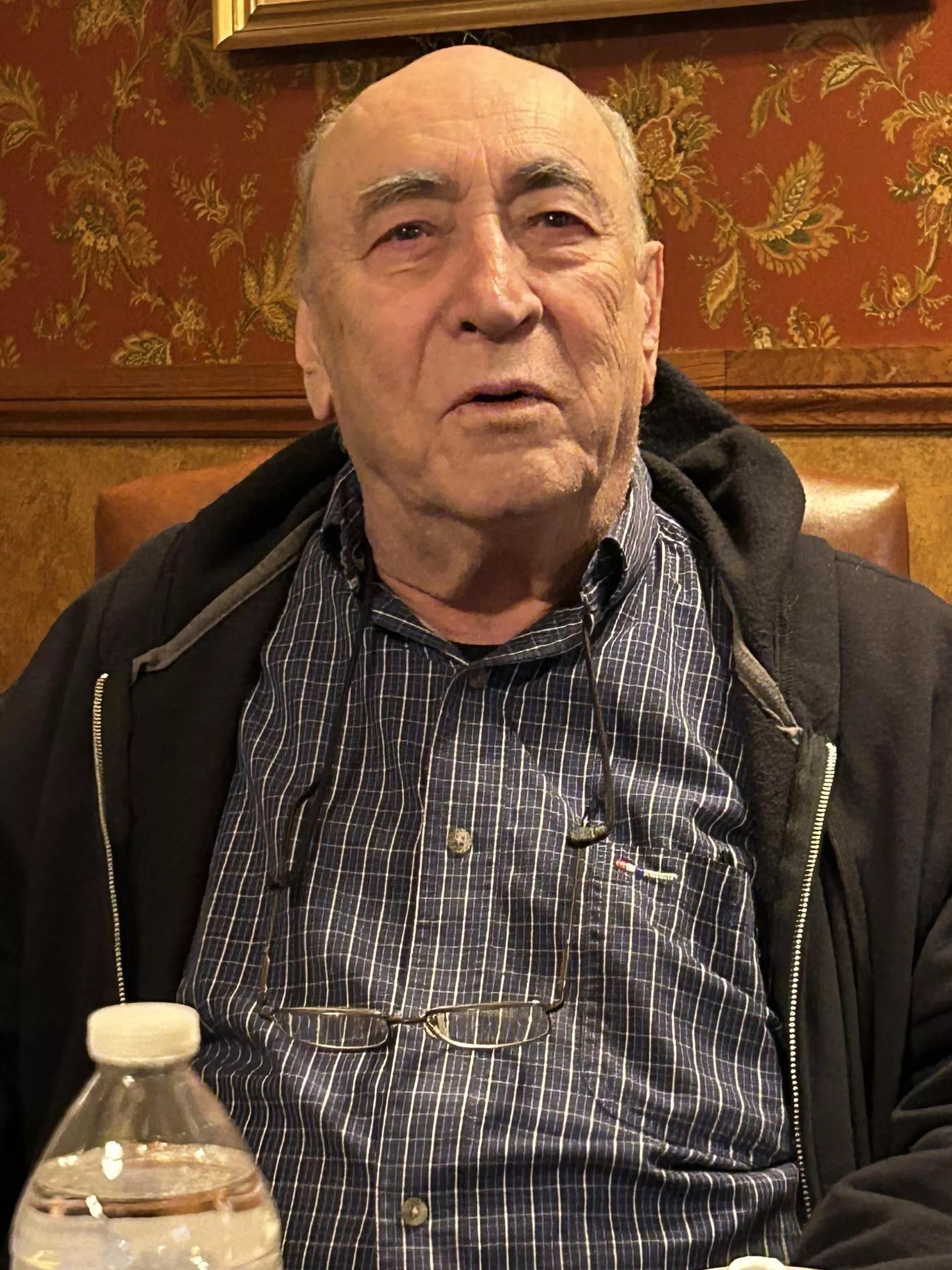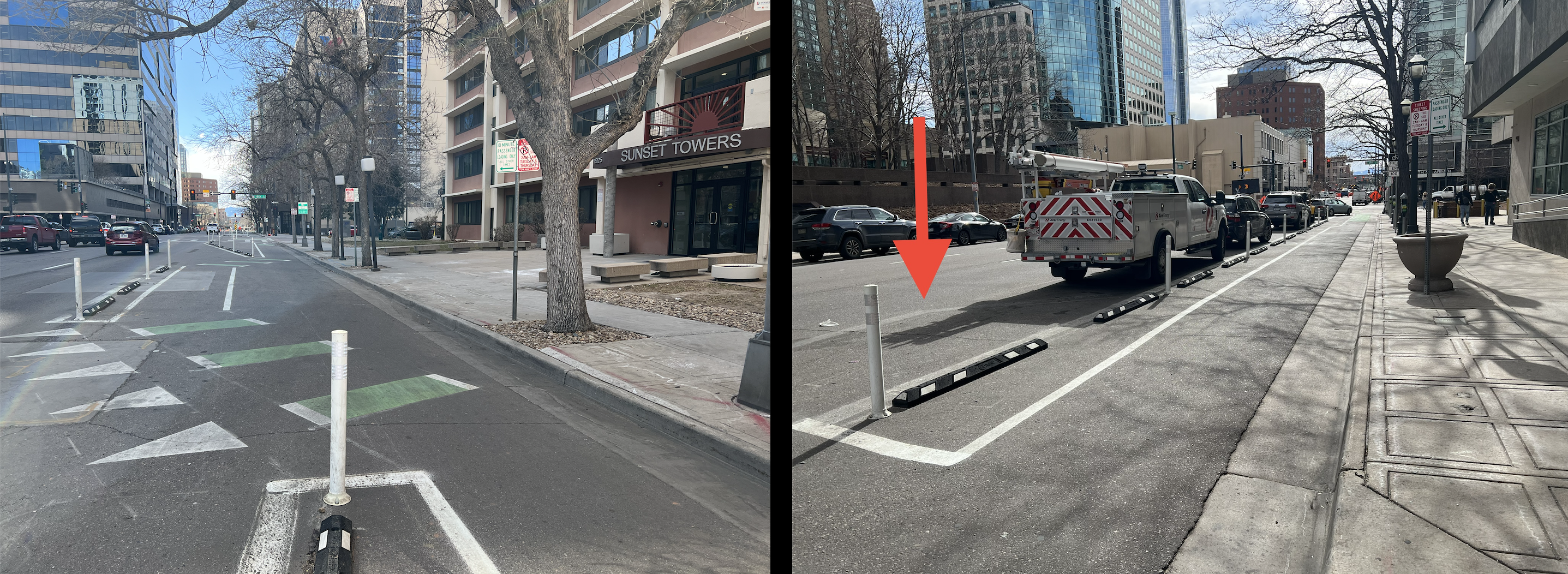
Hannah Metzger

Audio By Carbonatix
“It will be a matter of time before someone is killed.”
That’s what residents of the Windsor Condominiums told Westword in February after a new bike lane lined with posts and bumpers was installed in front of 1777 Larimer Street. Windsor residents must cross the bike lane to get from the designated drop-off area to the building’s entrance.
Bob Paolini had just been released from the hospital a week before after he tripped on the bike lane’s bumper while getting out of a friend’s truck, falling backward onto the asphalt. Paolini fractured his pelvis in the fall. Two days later, the injury led to another fall and another fracture. The 82-year-old ended up spending 22 days in the hospital, relying on a walker to get around and feeling hesitant to leave his building.
“I cannot fall again,” Paolini said at the time. But while still recovering from his injuries, another fall came in April, this time in his bathroom. Paolini was again hospitalized and, one week later, passed away due to endocarditis on April 16.
Denver, make your New Year’s Resolution Count!
We’re $12,000 away from reaching our $50,000 year-end fundraising goal. Your support could be what pushes us over the top. If our work has kept you informed and connected this year, please consider making a contribution today.
“Anyone that age falling on the street, it impacts them in ways you can’t always directly measure,” says Paolini’s son, Stephen. “The fall absolutely didn’t help him. Could that infection have come from the fall outside? It could have. We’re still puzzled about how he got that infection.”

Bob Paolini “lived and breathed” downtown Denver, his son says.
Courtesy of Dave Mahler
Stephen says it’s unclear to what extent the initial fall contributed to his father’s death. But some of Paolini’s friends and neighbors blame it on one thing: the bike lane.
“Bob’s passing is directly a result of a bad policy that the city made,” says Dave Mahler, a longtime friend of Paolini’s. “Bob would still be here but for the bike lane. … He never recovered after that first fall. He was so unstable at that point. It’s like he had no strength left in him at all.”
Paolini isn’t the only Windsor resident who’s had issues with the new bike lane, from tripping on the bumpers and posts to narrowly dodging speeding bikes and e-scooters. They’ve called the bike lane a safety hazard since it was installed in August.
More than 200 people live in the Windsor, some of whom bought into the project when it opened in 1981 as one of the first downtown condo developments. At least half of the residents are senior citizens, according to the building’s management, and many need to be picked up and dropped off outside of the building, which the bike lane makes hazardous.
When Westword first reported on the bike lane in February, Windsor residents said they had spent months complaining to the city, but the proposed solutions did not address their safety concerns. Now the city is taking further action.
The city has agreed to remove four of the rubber bumpers from the bike lane – the bumpers that Paolini tripped on – for the parking spaces in front of the Windsor that act as loading zones, says Nancy Kuhn, spokesperson for Denver’s Department of Transportation & Infrastructure. The three white posts that line the bike lane will remain in place.
“We are, of course, sickened to hear of the loss of this community member, as we mourn the passing of every person we are working every day to protect,” Kuhn says. “We will continue conversations with the Windsor if this doesn’t fully address their concerns.”
Kuhn says the decision was made “a couple of weeks ago.” There was no scheduled removal date as of May 30.
Before Paolini’s death, in response to complaints, the city designated two parking spaces in front of the Windsor as loading zones where cars can stop to pick up or drop off residents – but the bike lane still separates the loading zone from the curb, and the posts and bumpers are still in place. However, there will soon be one less hurdle for residents to navigate.
“It’s not going to help my father, but it could help other folks,” Stephen says. “I’m elated over that. I understand their intentions of having the blocks there, but I think it was an oversight on their part that they were placed where they were. …When you have people like my father who are older and less mobile, it makes it really difficult.”
Jack Walker, an 81-year-old who has lived in the building since 1995, says the city has not informed Windsor residents of plans to remove the bike lane’s rubber bumpers. While he says the change “will certainly help,” he argues that it’s not enough.
“The issue is still there,” Walker says. “There’s an accident still waiting to happen.”
Windsor residents want the same bike lane setup that’s outside the Sunset Towers senior living community, located just two blocks away on Larimer Street. At Sunset Towers, the bike lane bends around the building’s designated loading zone, so the loading zone is directly on the curb instead of being blocked by the bike lane.

The Sunset Towers loading zone (left) and the Windsor loading zone (right).
Hannah Metzger
Since the Windsor’s loading zone is separated from the curb, it creates accessibility issues for residents who use walkers and wheelchairs. Vehicle ramps cannot land directly on the sidewalk; instead, these residents must go down the bike lane and into the path of the parking garage exit to get to the nearest curb ramp. Or they must get dropped off at the handicapped parking space at the end of the block and travel uphill to the building, which can be strenuous for senior residents.
Kuhn said in February that the city allowed a “non-standard design” for the bike lane outside of Sunset Towers because its loading zone receives more than two dozen pick-ups/drop-offs every day from RTD’s accessibility and senior ride services, each of which lasts several minutes. The same situation doesn’t apply to the Windsor, whose senior residents say they primarily rely on family, friends and ride-sharing apps to get around.
Mahler says he fears this kind of bike infrastructure caters to the young and able-bodied at the expense of driving seniors like Paolini out of downtown.
“I don’t want to see all the seniors pushed to the margins for the sake of a few bike lanes. Their safety should be everybody’s concern, as well,” Mahler says. “For people who have lived and worked here all their lives, at least lend them an ear for the concerns they have and show them the respect that’s due to them.”
Paolini had lived in the Windsor since 1996. He was a U.S. Army veteran, a father of four and an avid cigar enthusiast, at one point opening several tobacco shops throughout the metro area. “He loved downtown Denver. He lived and breathed it,” Stephen says. “We moved to Colorado in 1972, and my father really adopted the city as his own.”
Walker says Windsor residents have discussed their concerns with the mayor’s office and two different Denver City Council members, Chris Hinds and Serena Gonzales-Gutierrez. Gonzales-Gutierrez says she will continue pushing for the city to reconfigure the Windsor’s bike lane to replicate that of Sunset Towers, arguing that having to cross the bike lane is still a safety issue, bumpers or not.
“I don’t see it as an exception, I see it as a necessity. They need to be able to be dropped off on the sidewalk,” Gonzales-Gutierrez says. “[The transportation department has] heard from the residents, they’ve heard now from two council offices. … I’m hopeful that they’ll change it. The unfortunate thing is, does it take somebody having to get so significantly hurt?”
Walker also plans to continue advocating for more changes to the bike lane.
“Given the tragic outcome of the death of Bob Paolini, I would hope the city would urge the Department of Transportation & Infrastructure to remedy the most dangerous situation in front of our building,” Walker says.
“This is not the last time this kind of accident is going to happen,” he adds.